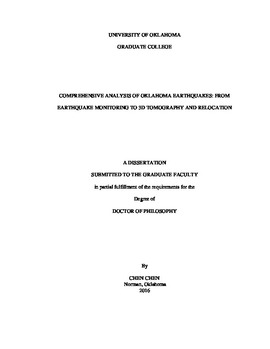| dc.description.abstract | A better understanding of the basement, such as rock properties and faults orientation, is critical to study the earthquakes in central Oklahoma. The active seismicity in this region provides a great opportunity to study the velocity structures in the basement. The earthquake location is an important parameter for seismology such as hazard assessments, fault studies, induced seismicity, and others.
In order to advance our understanding of the increase in seismicity occurring within Oklahoma and the resultant seismic hazards, I improved our ability to locate the earthquakes in three-dimensional (3D) space and improved the geological and geophysical model for central and north-central Oklahoma. I developed a pure Python package for automatically identifying the seismic phase types for earthquake monitoring, which is used for further seismological analysis, such as seismic tomography, focal mechanism studies, and others. A major result is a new 3D velocity model for the central Oklahoma region. The 3D velocity model provides new insights on the deep geologic features to depth of ~10 km, and significantly improved the earthquake locations.
In order to process the massive amount of seismic data that the Oklahoma Geological Survey seismic network records, I developed a Python phase identification package: the PhasePApy for earthquake data processing and near real-time monitoring. All the data formats supported by Obspy (a Python open library for seismology) are supported within the PhasePApy. The PhasePApy has two sub-packages: the PhasePicker and the Associator, aiming to identify phase arrival onsets (picks) and associate them to phase types (P-wave and S-wave), respectively. The PhasePicker and the Associator can work jointly or separately. Three autopickers are implemented in the PhasePicker sub-package: the frequency band picker, the Akaike Information Criteria function derivative picker, and the kurtosis picker. The PhasePicker triggers the pick with a dynamic threshold and can declare a pick with false pick filtering. Also, the PhasePicker identifies a pick polarity and uncertainty for further seismological analysis such as focal mechanism determination. There are two associators included in the Associator sub-package: the one-dimensional (1D) and three-dimensional (3D) Associator, which assign phase types to picks that best fit the predicted travel times of a potential earthquake by minimizing root mean square (RMS) residuals, respectively. Both associators use travel-time look up tables to determine the best estimation of the earthquake location and evaluate the phase type for picks. The PhasePApy package has been used extensively for local and regional earthquakes and can work for active source experiments as well.
Two 3D tomographic models for central Oklahoma are derived by employing different methods for central Oklahoma with P- and S-phase arrival times of local earthquakes. I created the first velocity model by using the FMTOMO package with 8194 M2+ earthquakes, the depths of which are greater than 3 km. I derived the second velocity model by using the SIMUL2000 package with 480 relative uniformly distributed composite events that include pick information from neighbor events within hypocentral distance less than 2 km. These two velocity models and Vp/Vs ratios show similar features on a large scale, but the model from SIMUL2000 has less velocity and Vp/Vs ratio variation. A strong lateral velocity heterogeneity within the Precambrian basement is present in both models, which indicates the presence of complex structures in the upper crust of central Oklahoma. By comparing velocity models to gravity and magnetic data, most of the large-scale velocity anomalies generally correlate with the previous known features within crystalline basement in north central Oklahoma, such as mafic intrusion associate with the Osage County Microgranite and Spavinaw Granite, Central Oklahoma Granite Group, and southwestern extension of the Mid-Continent Rift (MCR) arm. A low Vp/Vs ratio zone is identified in the upper basement for depths of ~3 to 10 km, which may be due to the water-filled fractures.
I obtained high-accuracy earthquake locations for central Oklahoma from 01/01/2010 to 03/31/2016 employing the new 3D velocity model. The 3D velocity model algorithm improved the absolute locations of the earthquakes with the SIMUL2000. A 3D double-difference method (HYPODD 3D) followed to improve the relative locations for the clustered earthquakes. The relocated earthquakes show a hypocenter distribution centered at depth about 5 km, which demonstrate that most earthquakes occurred within the upper part of the crystalline basement. Numerous relocated clusters present clearer northeast-southwest (NE-SW) and northwest-southeast (NW-SE) orientations after the 3D model relocation, which are consistent with maximum horizontal stress state within the study region. Some of clusters suggest unmapped faults in the crystalline basement. I also relocated the cataloged earthquake locations with the 1D velocity double-difference method (HYPODD 1D) to compare to the results of the 3D velocity relocation. Both the 1D and the 3D velocity relocations improved the relative earthquake locations, and showed clear and narrow cluster orientations, but there were systematic shifts between the results. The southern earthquakes mainly shifted westward, and the northern ones shifted southward. On average, the horizontal shift is about 0.7 km. | en_US |
